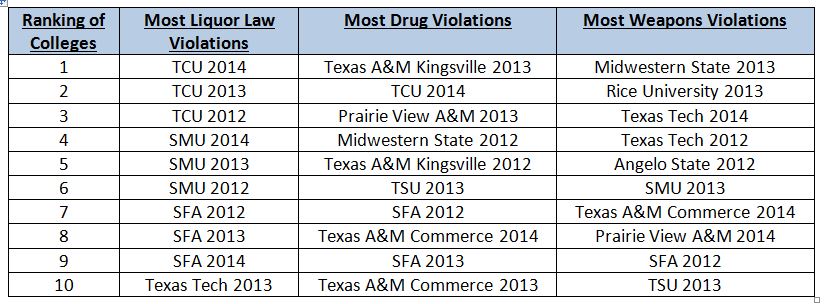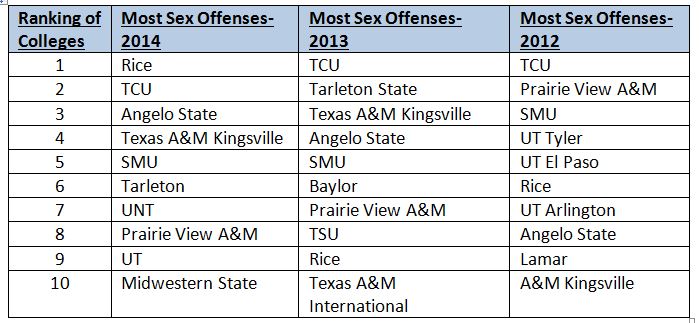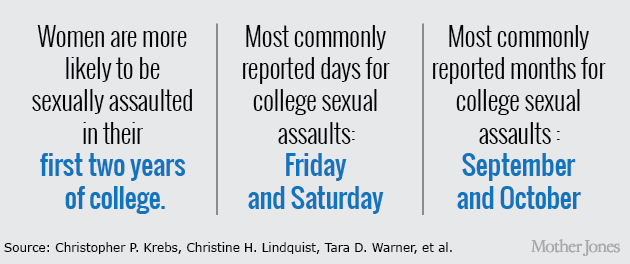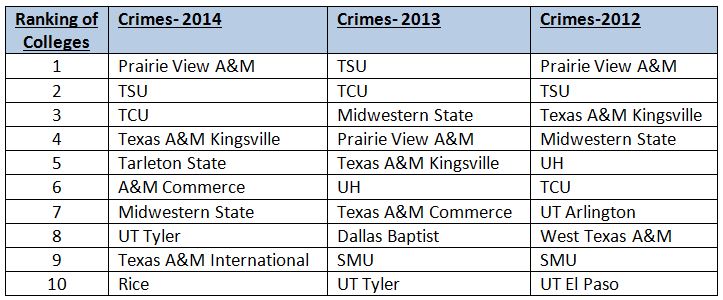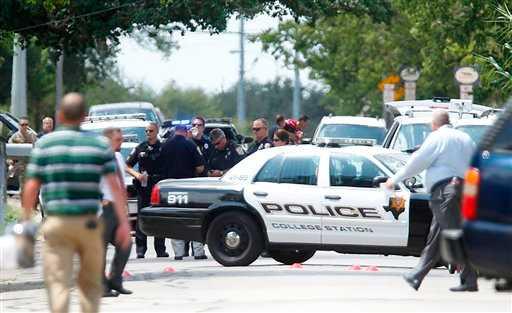Parents are always asking about college and student safety. Unfortunately, many families only base their information on the reputation of the college, its location, or rumors. To help families make more informed decisions, we 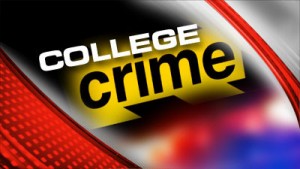 conducted a data search of Texas 4- year universities with student bodies of more than 5,000 students, excluding for-profit colleges and those without residential housing. We also compiled the data for years 2012, 2013 and 2014 to compare over time.
conducted a data search of Texas 4- year universities with student bodies of more than 5,000 students, excluding for-profit colleges and those without residential housing. We also compiled the data for years 2012, 2013 and 2014 to compare over time.
The first chart is the number of Disciplinary Actions taken against students at each campus. The definition of disciplinary action is the referral of a student to a college “official who initiates a disciplinary action of which a record is established and which may result in the imposition of a sanction.”
These disciplinary actions were then categorized into three categories: illegal weapons possession, drug violations, and liquor law violations. Because the size of the student body at these colleges vary from 5,000 to 50,000, it wouldn’t make sense to compare actual violation numbers, so we assessed each college’s data by looking at the number of violations divided by the number of students, which gives us a better comparison between the colleges.
Notable Issues
In the Liquor Law violations category, TCU had twice the number of violations, approximately 700 per year, than SMU, which had 300-350 each year. While Texas Tech also had 400 each year, it is three times the size of the smaller private schools.
In the Drug violations category, TCU is again having substantial problems: its drug violations doubled from 2013 to 2014, as did Texas A&M Commerce from 2012 to 2013.
The majority of colleges (60%) had no Weapons Violations each year. Most of the other colleges (30%) had 1-3 Weapons violations each year, but Texas Tech had an average of more than 8 weapon violations per year.
File- Texas Disciplinary_Actions_On_Campus
Criminal Offenses
The next chart we looked into was more serious: Criminal Offenses at each college campus. We categorized them into two parts:
- Sex Offenses- which includes rape, forcible fondling, non-forcible offenses, and statutory rape.
- Crimes- robbery, aggravated assault, burglary, vehicle theft, and arson.
Notable Issues
UT, UNT, and Rice had unusually large numbers for 2014: all three colleges were steady in 2012 and 2013, but then doubled the number of sex offenses in 2014. This is something that should be watched.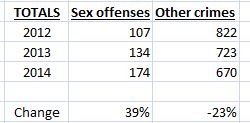
Unfortunately, the number of sexual crime on college campuses has increased overall. In 2012, 107 were reported, while in 2013, the number increased to 134. The number increased again in 2014 to 174, which is a 39% spike in two years, while the other crimes category saw a decrease in crime.
Notable Issues
Texas A&M (College Station), TCU, and UT Arlington all saw a spike in the number of aggravated assaults over the two years.
Some colleges have seen a sharp decline in burglaries and vehicle thefts including UH, SFA, Texas A&M, UT Arlington, and UT El Paso.
Arson is a rare crime on college campuses, with 75% of colleges reporting none and another 20% reporting only one or two arson crimes. The outliers- Texas A&M Commerce, Texas State, and Texas A&M Kingsville all had five or more in one year.
File- Texas Criminal_Offenses_On_Campus
Cautionary Note
The crime statistics found on this website represent alleged criminal offenses reported to campus security authorities and/or local law enforcement agencies. Therefore, the data collected do not necessarily reflect prosecutions or convictions for crimes. Because some statistics are provided by non-police authorities, the data are not directly comparable to data from the FBI’s Uniform Crime Reporting System which only collects statistics from police authorities.
